Chinese New Year Marketing Ranking – Luxury Handbags and Shoes Industry
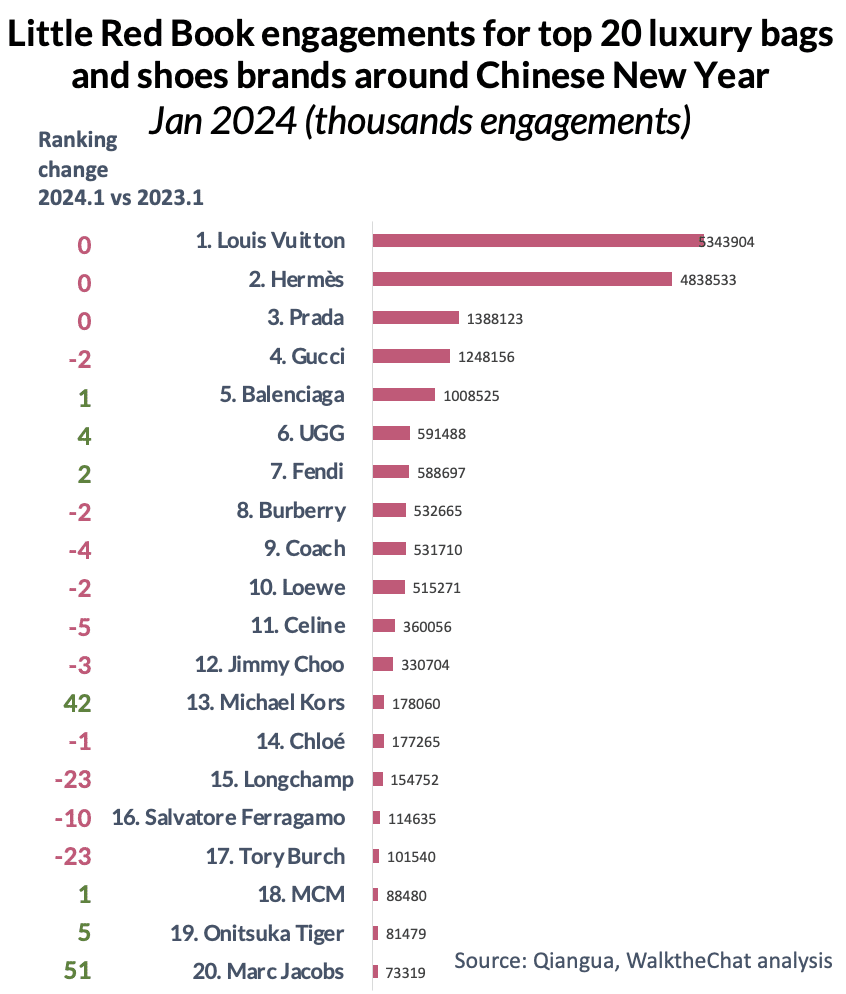
Chinese New Year marketing engagements include both brand and organic content.
Luxury Sector Chinese New Year Marketing Summary Insights
- The presence of offline artistic installations have increased significantly compared to last year during this Chinese New Year marketing season, indicating a more substantial investment in physical presence and engagement.
- Online interactions, especially through WeChat H5 games, have become more prevalent, with innovative red envelope (red packet) mechanisms being introduced to engage consumers.
- Marketing efforts have become more localized, as evidenced by the use of Chinese New Year-themed short films, which resonate more deeply with the local culture and traditions.
- There’s a noticeable reduction in collaborations with IP characters, particularly compared to those related to the Year of the Rabbit, likely due to the significant differences between Chinese and Western interpretations of dragons, which often spark discussions.
- Some brands have opted not to use dragon imagery in their campaigns, a departure from the previous year where rabbit motifs took dominance in Chinese New Year marketing campaigns and products.
- A deeper exploration of traditional Chinese culture beyond the obvious symbols like dragons and the color red
Offline artistic installations
The recent Chinese New Year marketing campaigns by luxury brands have showcased a significant uptick in the deployment of offline artistic installations, a testament to the brands’ heightened commitment to immersive customer experiences. This year, the venerable Louis Vuitton orchestrated an ephemeral pop-up space for its Spring/Summer 2024 Menswear collection in Shanghai and Beijing, drawing inspiration from the sun element—a central motif of Pharrell’s debut series as the brand’s Men’s Creative Director. This thematic choice reflected in the collection’s warm hues and ornamental luminosity was brought to life through these physical spaces, reinforcing the connection between the brand’s aesthetic narrative and its architectural manifestations.

Simultaneously, Louis Vuitton’s home in Chengdu’s Taikoo Li presented an even more eye-catching installation for the Year of the Dragon. Set against the backdrop of the millennial Daci Temple with its two standalone buildings and an open courtyard, the installation featured a commanding dragon that encapsulated the charm of the “Land of Abundance,” resonating with both cultural significance and contemporary relevance.
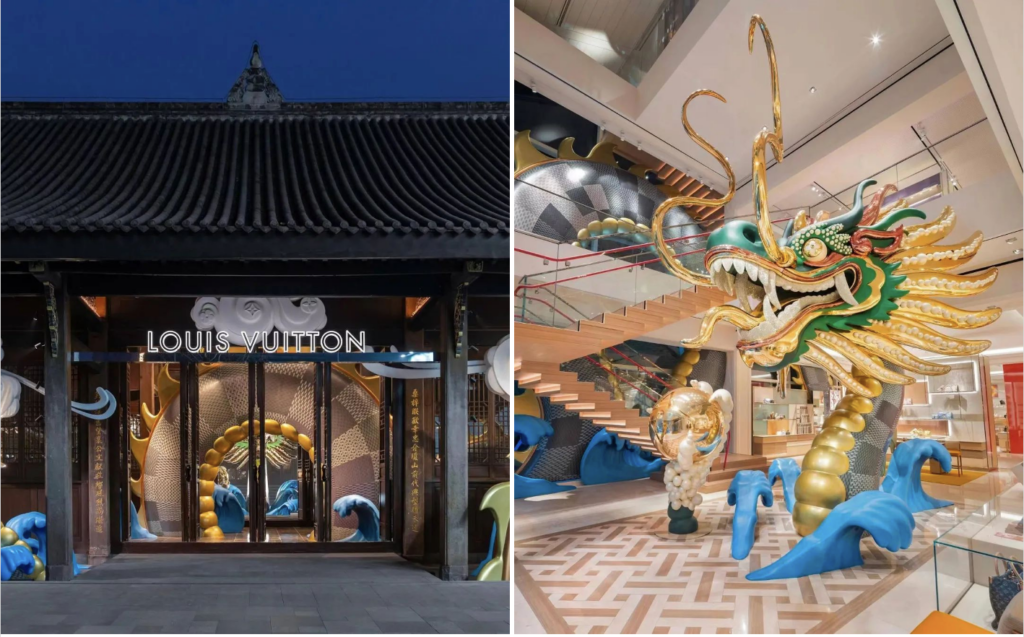
Moreover, Italian luxury brand Fendi seized the festive period as an opportunity to launch a collaboration featuring the iconic Pokémon franchise and Japanese streetwear designer Hiroshi Fujiwara’s Fragment. The Fendi x Fragment x Pokémon collection integrated beloved dragon-themed characters from Pokémon with Fendi’s highly recognizable Peekaboo and Baguette bag designs, merging them with the classic FF motif. This creative synergy was celebrated with a unique flash store in the East Square of Chengdu’s Taikoo Li, showcasing the innovative interplay between iconic brand symbols and pop culture elements.
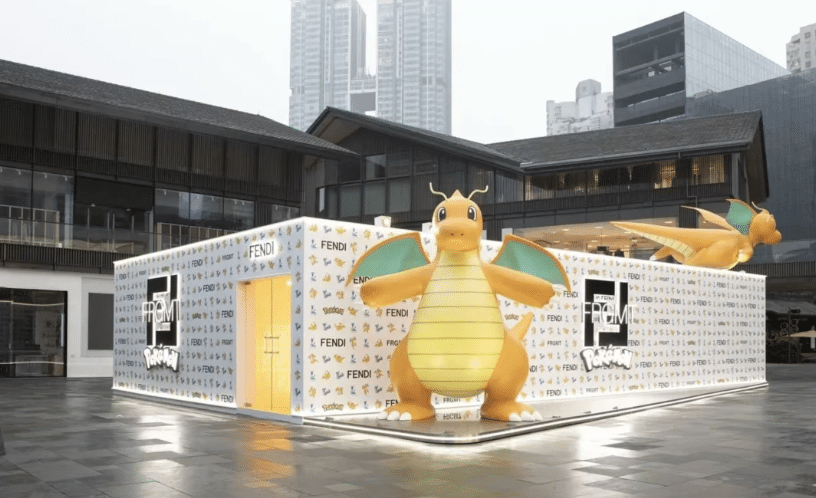
These installations exemplify how luxury brands are increasingly investing in elaborate, tangible art pieces to elevate their in-person engagement, crafting an intertwined narrative of tradition and modernity that not only captures the imagination but also creates distinctive, memorable experiences for consumers.
Evolving digital engagement and WeChat mini-programs
This Chinese New Year marketing season, luxury brands significantly leveraged WeChat mini-programs for heightened user interaction, offering exclusive red packet covers, wallpapers, and emoticons. Unlike the direct claim methods of previous years, more brands now require entry and registration via mini-programs, capturing valuable consumer data for future marketing endeavors (e.g., targeted SMS campaigns). The engagement strategies have evolved, incorporating keyword searches, link sharing, and interactive games to unlock exclusive content, enriching the user experience. WeChat’s latest module template enabled brands to integrate ads, lucky draws, and product promotions seamlessly, maximizing engagement.
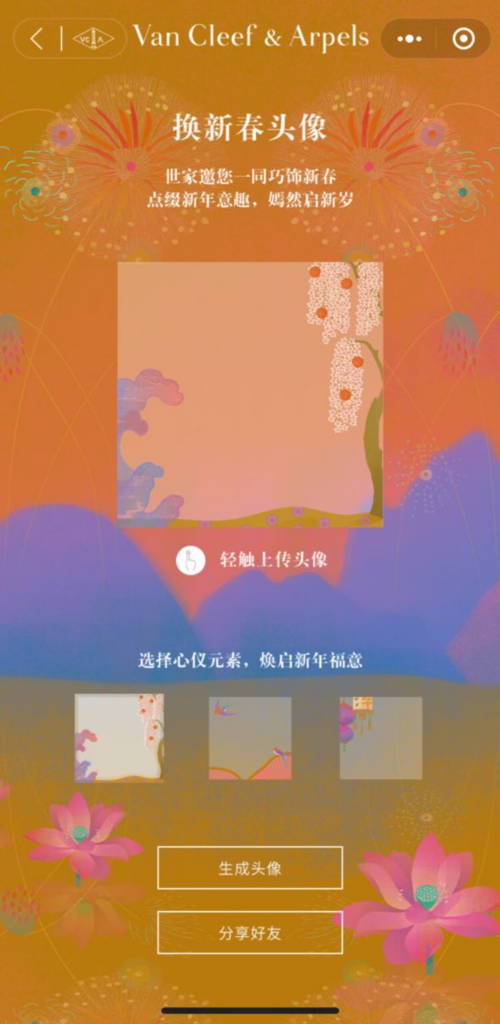
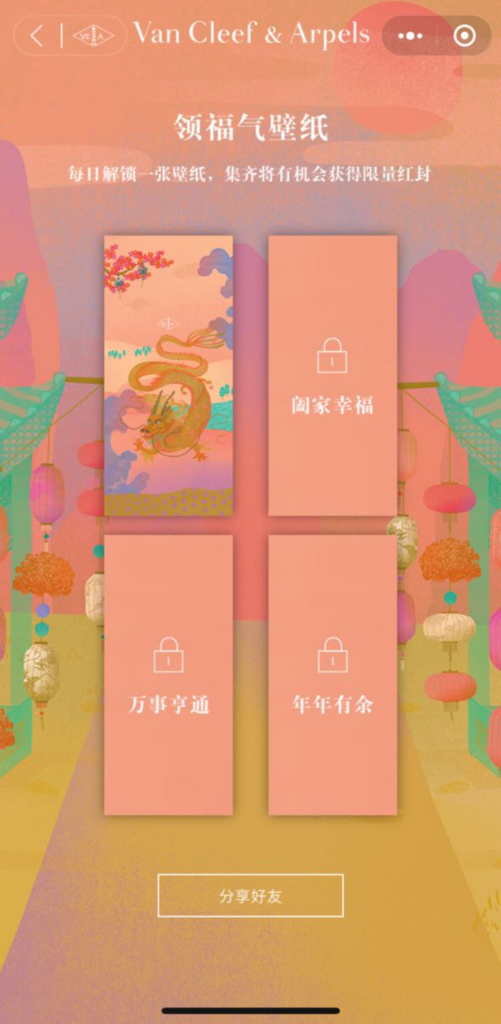
Van Cleef & Arpels introduced a Chinese New Year marketing interaction that included dragon-themed emoticon packs, the collection of lucky wallpapers (with a chance to win a hidden red packet cover upon gathering all four designs), and a new year avatar update feature (where users could upload their portrait to generate a themed avatar).
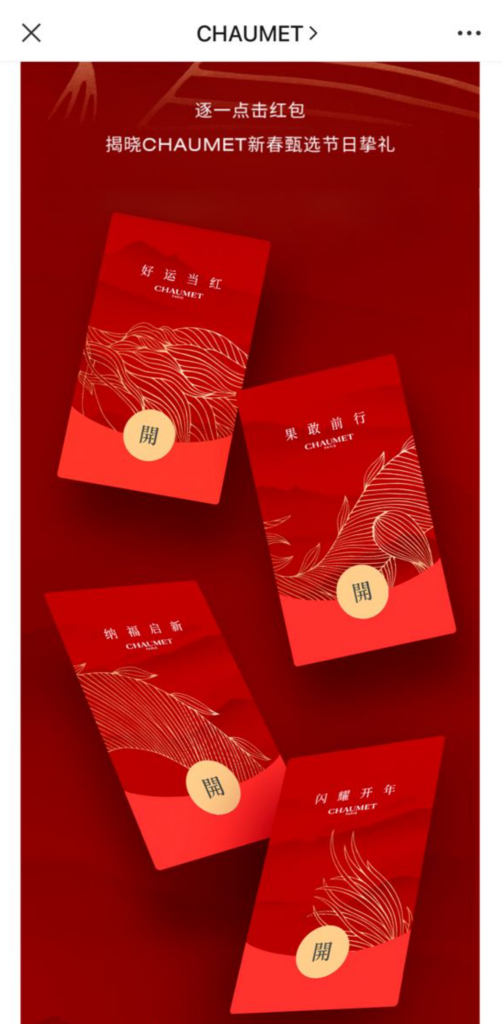
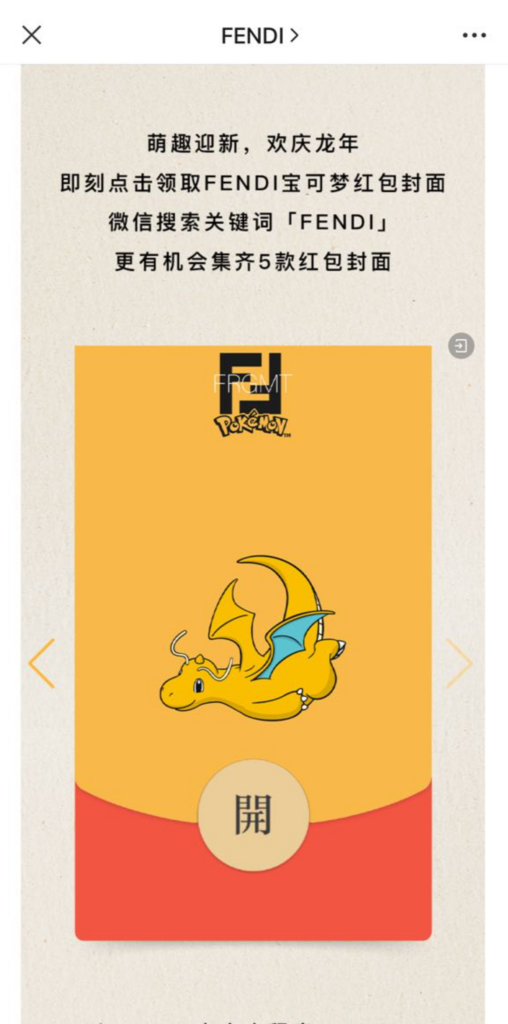
In terms of private domain marketing, after retaining user information, luxury brands like Balenciaga are sending text messages to users, increasing consumer touchpoints.
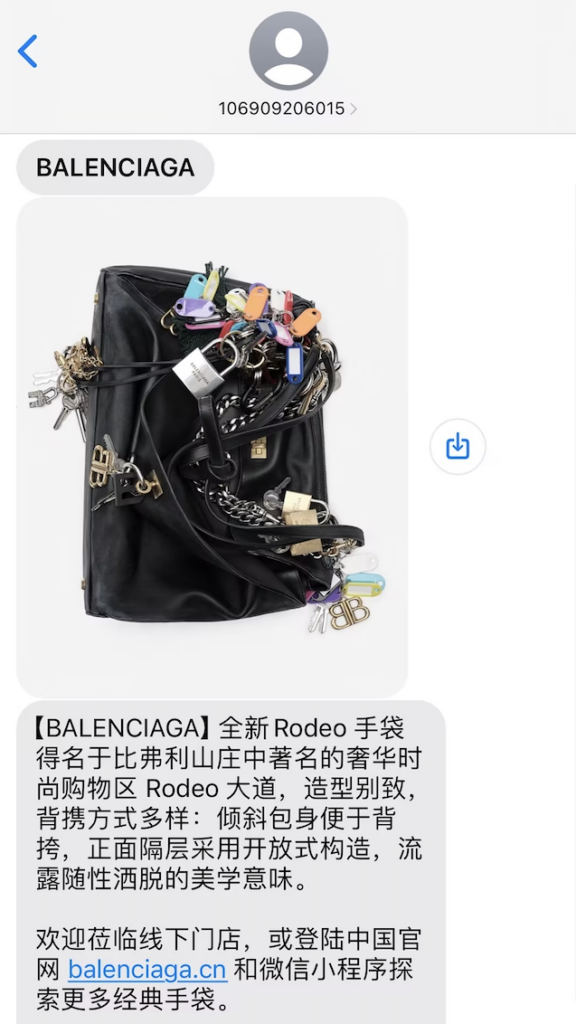
Other brands, such as Hermès, utilized the limited edition red packet covers as a tool for sales associates (SAs) to connect with clients, with SAs sending them directly to customers via private messages.
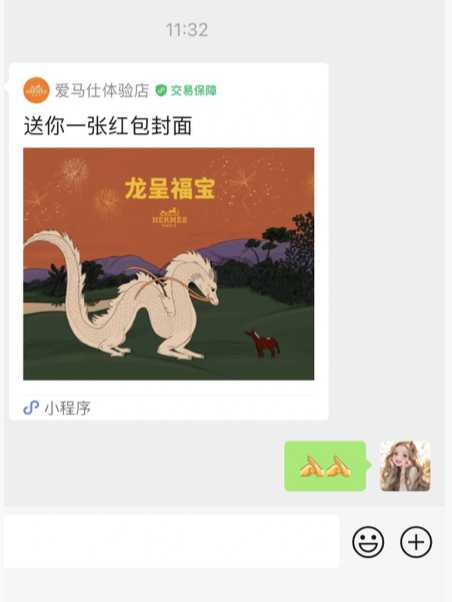
This approach not only enhanced direct engagement but also leveraged personalized communication to strengthen brand loyalty and consumer relationships.
Localized storytelling in New Year campaigns
This year, luxury brands have continued the tradition of crafting New Year campaign films, focusing on themes of “hope and expectations,” “prospects and the future,” and “identity,” particularly addressing the existential concerns of contemporary youth. Post-pandemic, these narratives extend beyond the timeless New Year themes of “homecoming” and “reunion dinners,” aiming to resonate emotionally through localized storytelling that simplifies complexity, showcasing respect and sincerity towards cultural nuances.
-819x1024.png)
-819x1024.png)
Bottega Veneta’s “The First Sunrise with You” captures the essence of new beginnings and the relentless pursuit of life’s journeys through the lens of traditional reunion themes, interwoven with the anticipation of dawn’s first light. This narrative not only aligns with the cultural significance of greeting the New Year but also addresses the aspirations and anxieties of modern Chinese society, showcasing a deep respect and understanding of local sentiments.
-766x1024.jpg)
-769x1024.jpg)
Though not a luxury fashion brand, Ganni’s campaign, inspired by the traditional “dragon boating,” is a noteworthy one. It connects with Chinese cultural heritage while highlighting themes of female empowerment and collective strength. By depicting athletes overcoming limitations through unity and determination, the campaign resonates with the contemporary Chinese values of resilience and community, reflecting the brand’s commitment to embracing and honoring Chinese traditions and the evolving identity of its people.
Declining IP collaborations and cultural interpretation challenges
In the Year of the Rabbit, fashion brand marketing frequently featured collaborations with designers and iconic cartoon characters, such as Coach x White Rabbit, Chloé x My Melody, Givenchy x Lucky Rabbit Ozwald, and Moncler x Roger Rabbit. This year, however, there’s been a noticeable decrease in such IP collaborations. Even those that have launched face scrutiny, particularly regarding their relevance to the “Chinese Dragon.”
-957x1024.png)
Dior’s partnership with Japanese contemporary artist Otani Workshop produced a green monster TANILLA. Upon release, many criticized it for not representing the “Chinese Dragon,” with feedback ranging from its appearance being “ugly” and “abstract” to outright “ghastly.”
-1024x617.png)
Products featuring this design, including jackets with a burnt color effect, prints that obscure the face, and dragon scarves with an unclear motif, have been particularly disparaged. Some netizens dubbed the design as a “zombie dragon,” neither festive nor auspicious, predicting it to quickly become discounted stock.
-1024x595.png)
This backlash underscores the unique emotional connection Chinese people have with zodiac symbols, expecting the Chinese dragon to embody power and protection, not the characteristics of a “dinosaur” or a “European-style evil dragon.” This mismatch in cultural expectations likely contributed to the reduced number of IP collaborations this year, as brands aim to avoid controversy and more deeply respect traditional Chinese sentiments.
Creative approaches beyond literal dragon imagery
This year, in contrast to the rabbit-themed marketing saturating last year’s campaigns, several brands have strategically refrained from directly incorporating dragon imagery into their Chinese New Year products. Seeking a more creative and thematic approach to zodiac marketing for the Year of the Dragon, these brands have found innovative ways to honor the dragon theme without resorting to explicit depictions.

Bottega Veneta utilized its sophisticated weaving techniques to mimic dragon spines and scales, subtly celebrating dragon culture through craftsmanship rather than literal representation.


Givenchy, in collaboration with Juanzong Bookstore, released the 2024 Dragon Scale Scroll, drawing upon the classical Chinese bookbinding method known as dragon scale binding, named for its pages that fan out resembling dragon scales.


Loewe tapped into the Chinese appreciation for jade and its symbolic meanings. The brand commissioned jade carving masters to create three limited-edition jade pendants. Additionally, each jade-color-inspired Flamenco Mini clutch bag comes with a special pouch containing a jade piece in a matching color, symbolizing good fortune for the new year.
Cosmetics Industry Chinese New Year Marketing Ranking
Compared to 2023 Chinese New Year marketing, most international brand rankings for Chinese New Year do not show big changes. Young cosmetic brands have exhibited remarkable growth, including brands like TIMAGE, First Impression, and JUDYDOLL. The rankings for established brands such as Chanel, Dior, and Giorgio Armani show relatively stable positions with minimal changes.
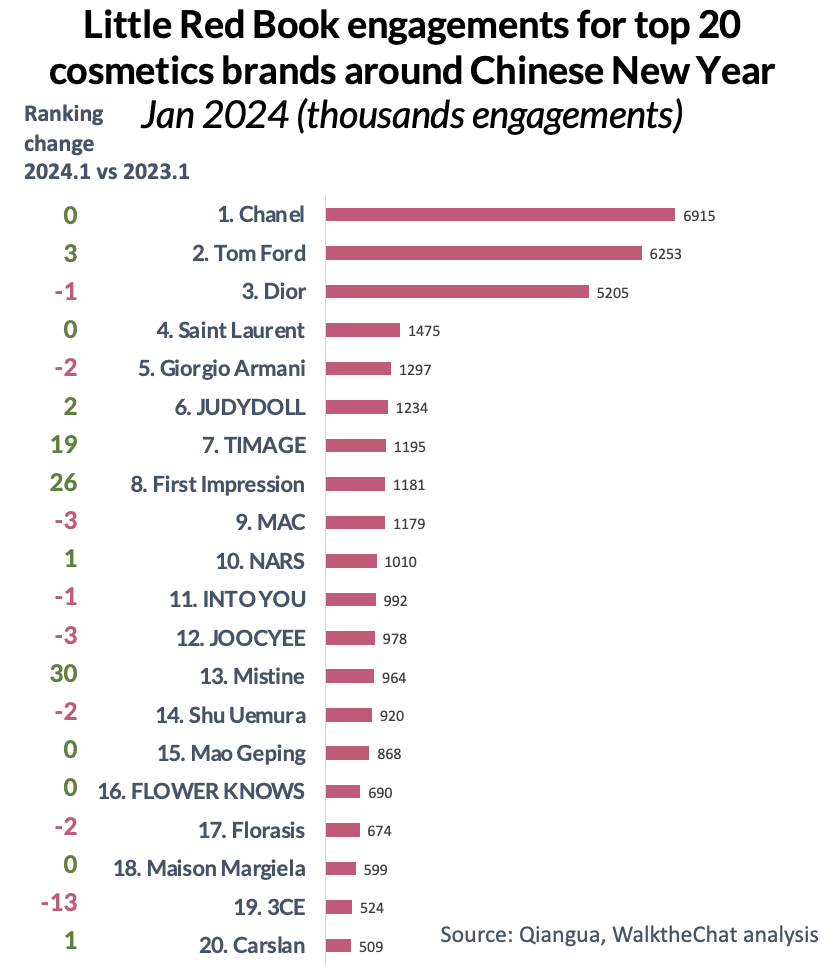
There is a dynamic and rapidly growing market for brands that are relatively young in the market, which are becoming increasingly competitive and are resonating more with local consumers.
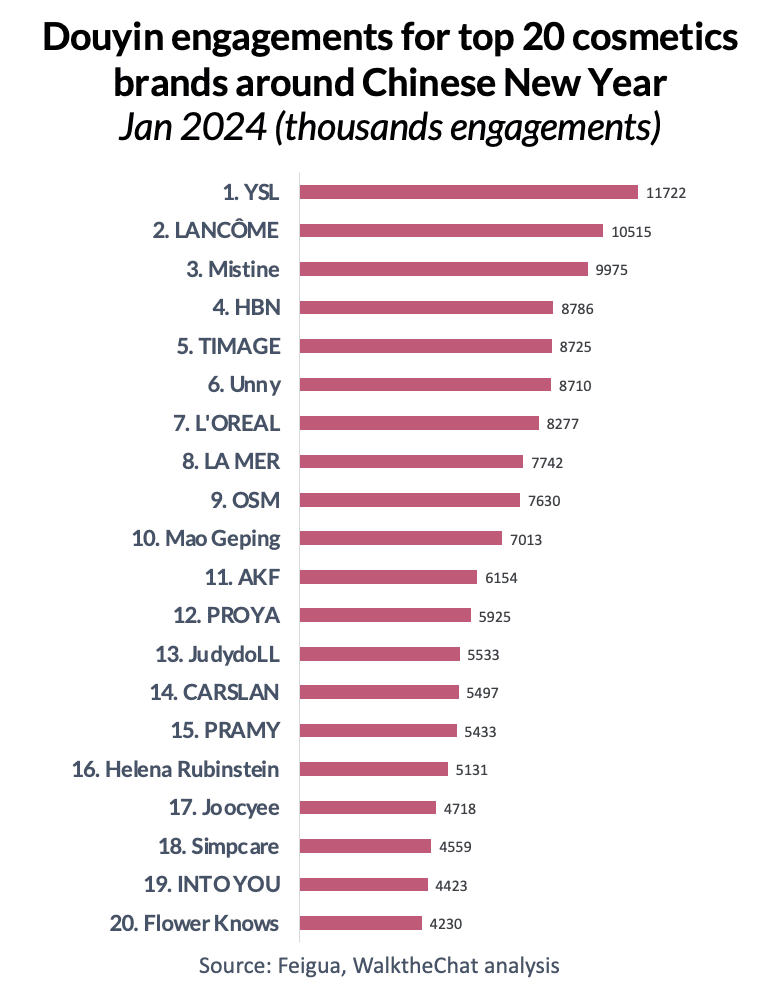
Douyin’s cosmetics sales are growing at a strong rate, with a 111% GMV growth in Jan 2024. Comparatively, Tmall’s cosmetics category has a 12% decrease during the same time, showing that it is losing traction to Douyin.
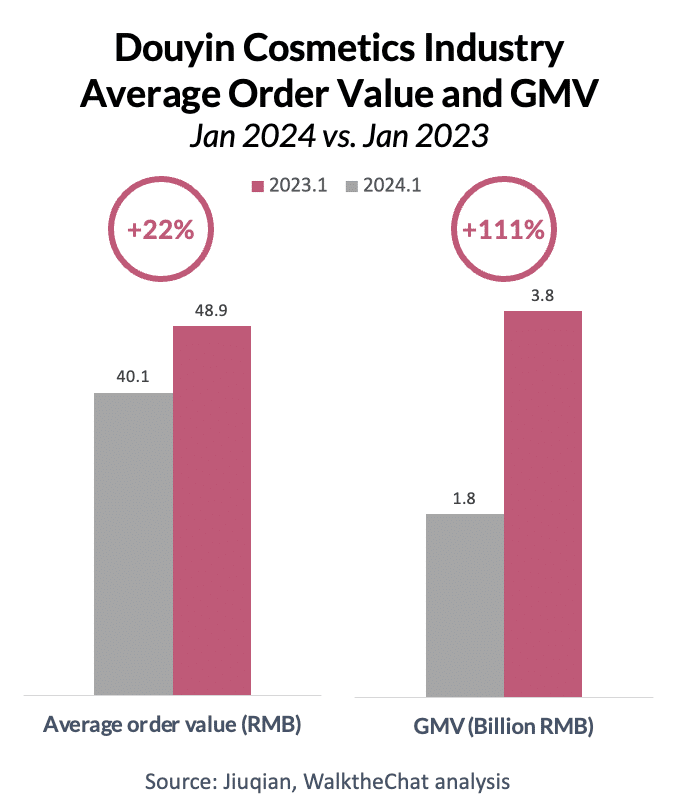
Shu Uemura plays with Nostalgia Marketing and cultural alignment
In the Chinese New Year marketing campaign by Shu Uemura, contrasting outcomes from collaborations with two distinct celebrities highlight an important strategic consideration. The brand’s engagement with Wang Yibo, a prominent figure with substantial influence among younger audiences, indeed generated significant short-term traffic. However, this approach, often characterized by hefty endorsement costs, may not ensure a sustained interest in the brand itself, as the followers are typically more celebrity-driven rather than brand-loyal.
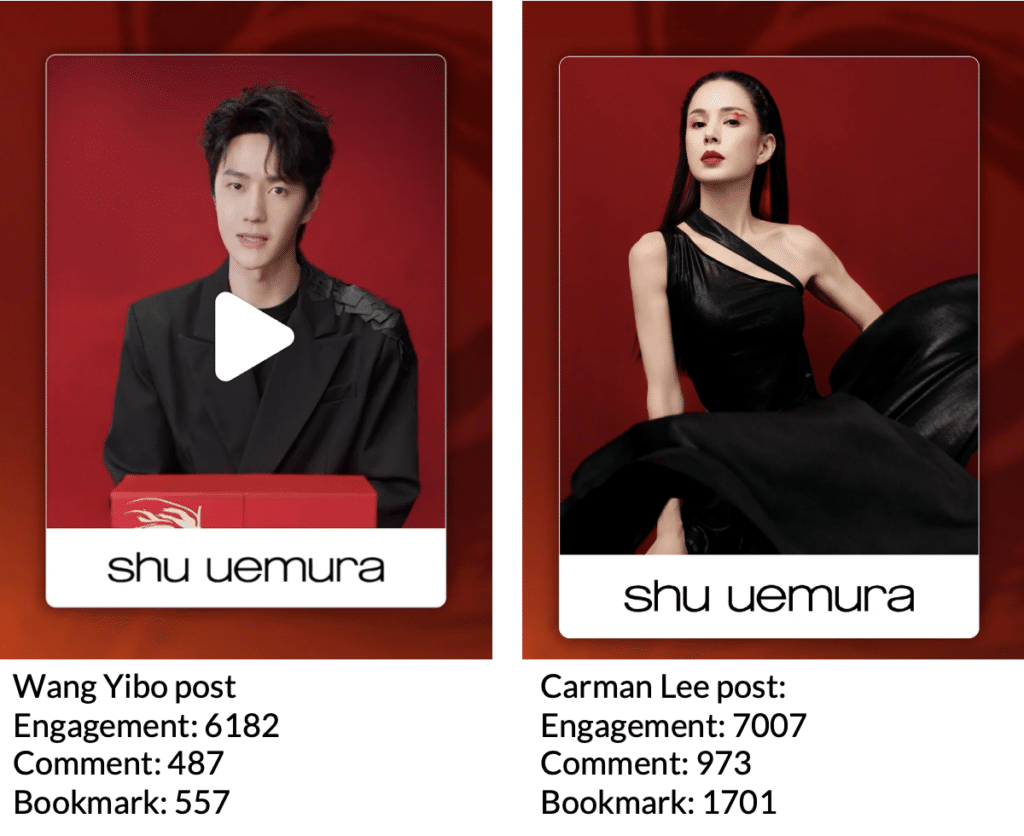
Conversely, the partnership with Carman Lee (李若彤) tapped into a more profound cultural and nostalgic vein. She is an actress revered for her portrayal of Xiaolongnü, the ethereal ‘Dragon Girl’ from the famed ’90s TV series “The Return of the Condor Heroes”.
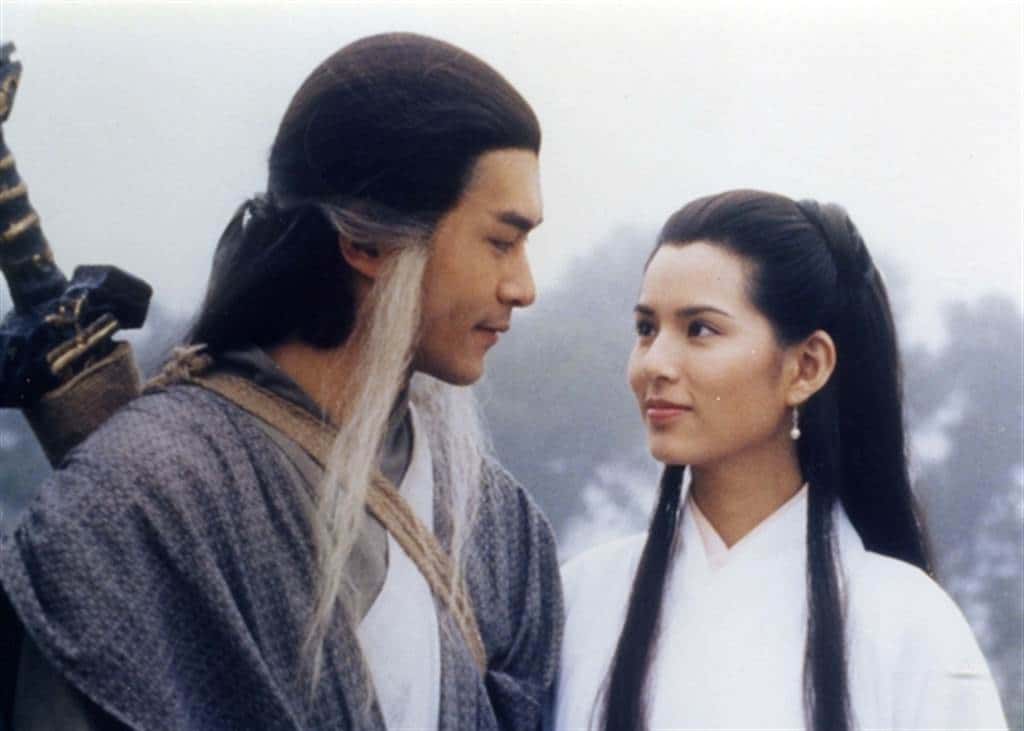
Her association with the character Dragon Girl deeply rooted in the cultural fabric, presented an authentic alignment with the brand’s campaign theme, resulting in higher engagement and bookmarking figures. The Little Red Book post featuring her got over 7000 engagements with a much higher comment rate and bookmark rate compared to that of Wang Yibo. This suggests a more enduring connection with consumers. Carman Lee’s influence comes at a likely lower cost, yet it appears to resonate on a more substantial level, potentially leading to a lasting affinity with the brand beyond the campaign’s run.
With a 12% annual decline in China’s cosmetics sales in 2023, the reliance on tier 1 celebrities for quick traffic surges might not be the most prudent financial commitment. Brands should consider a balanced approach that combines the widespread reach of popular figures with influencers who have a more resonant cultural or niche appeal. This dual strategy could optimize marketing budgets while fostering a deeper and more sustainable relationship with consumers, steering clear of transient trends and instead building a loyal customer base rooted in shared values and cultural relevance.
Conclusion
Luxury brands have adeptly navigated the festive Chinese New Year marketing period, unveiling a blend of innovative physical and digital marketing strategies. By emphasizing offline artistic installations, alongside the smart use of WeChat mini-programs for interactive digital engagement, brands have created immersive experiences that establish multi-touchpoints with consumers. Coupled with a shift towards localized storytelling and creative interpretations of zodiac themes, luxury brands show commitment to marrying tradition with modernity, ensuring cultural relevance and fostering deeper consumer connections without leaning on explicit or potentially culturally insensitive imagery.
In the cosmetics industry’s Chinese New Year marketing, a notable shift favoring Douyin’s digital platform. The remarkable growth of brands like TIMAGE and Douyin’s 111% sales increase underscore the changing consumer dynamics. Additionally, Shu Uemura’s nostalgia-driven campaign with Carman Lee highlights the power of culturally resonant marketing.
Overall, Chinese New Year marketing reveals a sophisticated interplay between tradition and innovation across the luxury and cosmetics industries. By integrating artistic installations and digital interactivity, embracing localized and culturally nuanced content, and strategically leveraging nostalgia and celebrity influence, brands have demonstrated a nuanced understanding of the Chinese market, setting a precedent for future marketing strategies that prioritize cultural sensitivity, creativity, and authentic connections, ensuring the continued relevance and appeal of luxury brands in a rapidly evolving consumer landscape.
__________________
WalktheChat is an AI-powered China Marketing Agency supercharged with an industry-leading AIGC and tech team.
Follow us on LinkedIn for more news and insight about China’s digital marketing and luxury landscape.
More reports available upon request.
Contact us at: info@walkthechat.com

